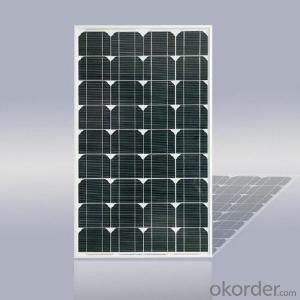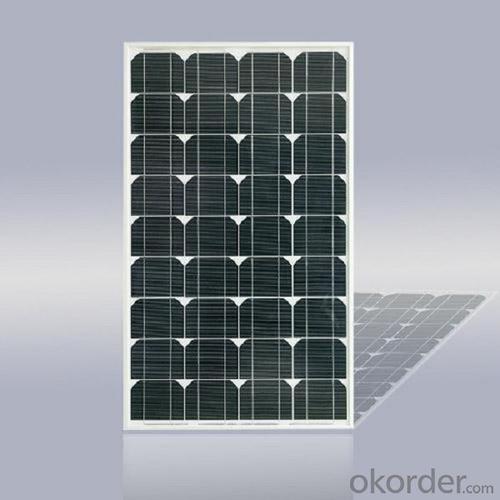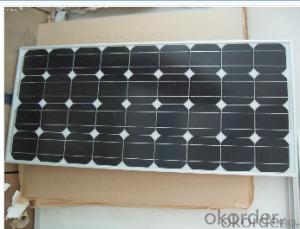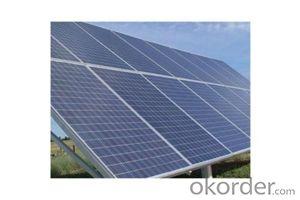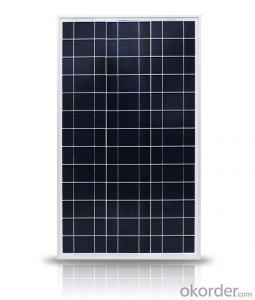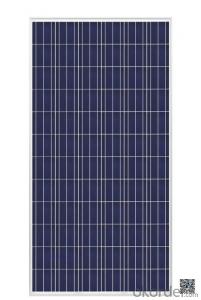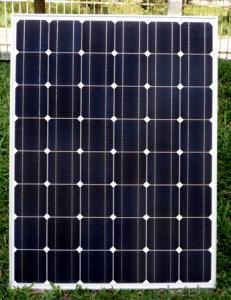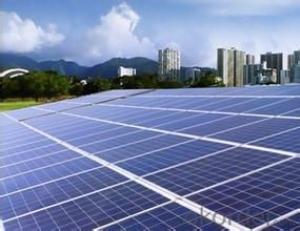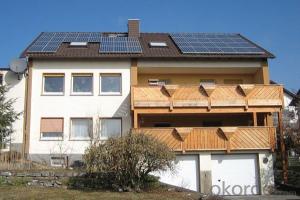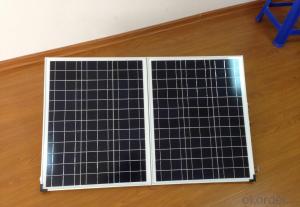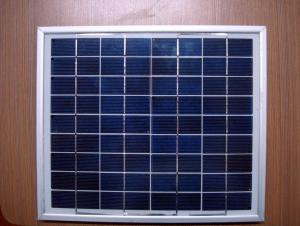Generac Solar Panels - Solar Panel Mono, Solar Module for Best Price in China
- Loading Port:
- Shanghai
- Payment Terms:
- TT OR LC
- Min Order Qty:
- 2600 watt
- Supply Capability:
- 26000 watt/month
OKorder Service Pledge
OKorder Financial Service
You Might Also Like
Specification
We now provide
• Monocrystalline Solar Panel
• Polycrystalline Solar Panel( multicrystalline silicon Solar Panel)
Features of our products:
• High conversion efficiency mono/poly-crystalline amorphous silicon solar cells
• Modules incorporate high performance bypass diodes to minimize the power drop caused by shading
• High transmittance, low-iron tempered glass
• High performance EVA encapsulant to prevent destroying and water.
• AI frame: without screw, corner connection. 8 holes on the frame can be installed easily
• Good performance of preventing from atrocious weather such as wind and hails
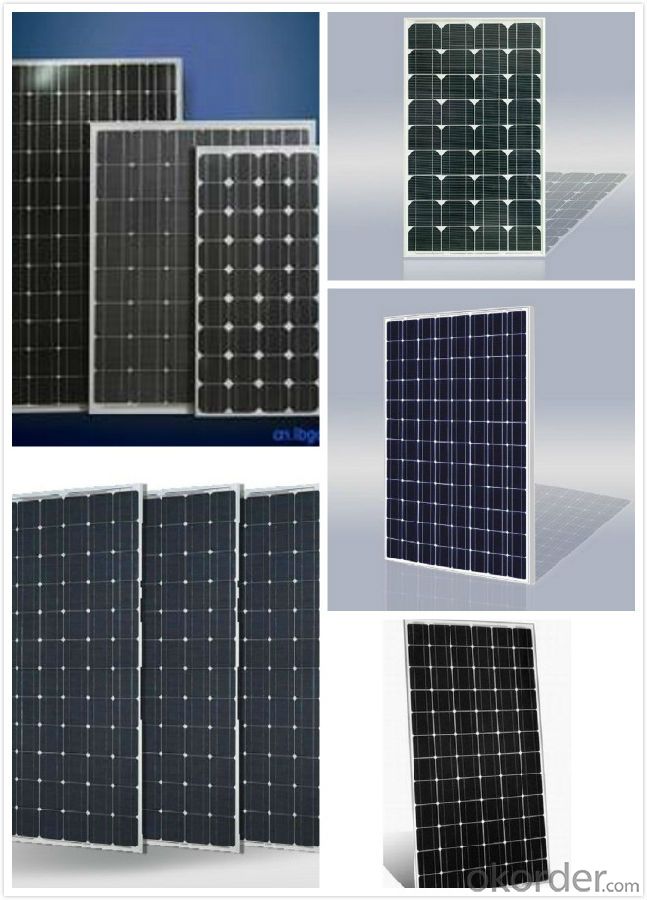
Product Description:
CUSTOMER does not assume responsibility and expressly disclaims liability for loss, damage, or expense arising out of in anyway connected with installation, operation, use or maintenance of the PV modules. No responsibility is assumed by CUSTOMER for any infringement of patents or other rights of third parties that may result from use of PV module.
CUSTOMER reserves the right to make changes to the product, specifications or installation manual without prior notice.
Solar panel working process
In addition to being the ultimate source of all life on earth, the sun is an infinitely renewable, completely pollution-free source of electricity. Instead of burning fossil fuels dug up from the ground in a big power plant – a very 19th century, industrial age approach, when you think about it – solar panels convert sunlight directly into electricity, with no harmful emissions.
The basic unit of a solar panel is a solar cell, which usually consists of one or two layers of silicon-based semiconductor wafers. When struck by the photons in sunlight, the solar cell generates an electrical charge due to the "photovoltaic effect" – which is a pretty good name, since it produces voltage from photons. The flow of these electrons moves in a steady electrical current from one side of the cell to the other.
Dozens of these PV cells are packaged together into solar modules, which in turn are packaged into solar panels that are mounted on a rooftop and arranged to maximize their hours of exposure to direct sunlight. Because the electricity generated by all those solar cells is direct current (DC), it is then sent to an inverter that transforms the power into the same alternating current (AC) used by the appliances in your home and the local utility electricity distribution grid. Increasingly, these inverters are getting "smart," providing data monitoring for solar installation performance and other grid integration services.
- Q: Can solar panels be installed on a factory or manufacturing plant?
- Yes, solar panels can be installed on a factory or manufacturing plant. In fact, many industrial facilities are increasingly adopting solar power as a sustainable and cost-effective energy solution. Installing solar panels on factory rooftops or open spaces can help offset electricity consumption, reduce carbon emissions, and provide long-term savings on energy bills.
- Q: How do solar panels affect the overall energy security of a building?
- Solar panels can greatly enhance the overall energy security of a building. By harnessing the sun's energy, solar panels provide a reliable and sustainable source of electricity. This reduces a building's dependence on traditional energy sources, such as fossil fuels, which are finite and subject to price volatility or supply disruptions. Solar panels also contribute to grid resilience, as they can continue generating power even during power outages. Consequently, incorporating solar panels into a building's energy mix can enhance its energy security by diversifying its energy sources and promoting self-sufficiency.
- Q: Please tell me what they are made of and how the materials help the solar cell produce electricity. Im doing a science projects so i need help on knowing all this info. Its a debate, so i need correct information please.I will please need more information about the bad things about solar energy and solar panels. Please say what solar panels do to create pollution or do anything that is not friendly to the environment. If you want just give me a website. Thank you
- image voltaic cells paintings for the period of the photoelectric effect. Incoming photons knock out electrons of the textile, which being a semiconductor helps a small ability distinction. close to to the sunlight, each and everything could be very severe (like a Van Halen gig), radiation, energetic ions, magnetic fields, the works. of direction, NASA project planners could take all those issues into consideration. i ask your self what textile maintains to be stable at 5800? ok (or perhaps it fairly is not needed), and captures all photons of all energies, to be one hundred% powerful. The link provided by making use of Snow Blossom is extremely thrilling. I do in simple terms no longer look waiting to study the secondary link Thermophotovoltaics. Edit: image voltaic Flares may well be a difficulty. they're by making use of and great unpredictable, upward push for hundreds of miles, achieving hundreds of thousands of Kelvin.
- Q: Can solar panels be used to power a film set?
- Yes, solar panels can be used to power a film set. By harnessing the sun's energy and converting it into electricity, solar panels can provide a sustainable and renewable source of power for various film production needs, such as lighting, cameras, and equipment. This not only reduces the carbon footprint of the film production but also saves costs on traditional energy sources.
- Q: Can solar panels be used in commercial buildings or industrial settings?
- Yes, solar panels can be used in commercial buildings or industrial settings. In fact, they are increasingly being incorporated into such environments to offset energy costs, reduce carbon footprint, and promote sustainability. Solar panels can be installed on rooftops, parking lots, or even as part of building facades to generate clean electricity that can power various operations in commercial or industrial facilities.
- Q: Can solar panels be used for powering a mining operation?
- Yes, solar panels can be used to power a mining operation. Solar energy can be harnessed and converted into electrical power to meet the energy demands of a mining operation. This renewable energy source can provide a sustainable and environmentally friendly alternative to traditional fossil fuel-based power generation, reducing carbon emissions and operating costs. However, the feasibility and effectiveness of using solar panels for mining operations may depend on factors such as the scale of the operation, location, available sunlight, and energy storage solutions.
- Q: How do solar panels impact the local job market?
- Solar panels have a positive impact on the local job market as they create new employment opportunities in the renewable energy sector. The installation, maintenance, and manufacturing of solar panels require skilled workers, which leads to job growth and economic development in the community. Additionally, the transition to solar energy promotes a shift towards clean energy sources, attracting more investments and creating a sustainable job market for the future.
- Q: Looking to install solar panels in my house.
- Wholesale prices for BP solar panels range between $335 for the 40 watts panel to $835 for the 70 watts panel. Here's a brief listing of wholesale prices for BP solar models: - BP340J solar panel (40 watts) @ $335 - BP350J solar panel (50 watts) @ $37 - BP375J solar panel (80 watts) @ $504 Right now I'm getting a series of 50 watt (7.5 volts) panels installed in my house. It's a start to reduce dependence on electricity bills and try get some tax rebates as well.
- Q: Can solar panels be installed on tile roofs?
- Yes, solar panels can be installed on tile roofs. However, the installation process may require additional precautions and expertise to ensure the integrity of the roof.
- Q: The inverter I am using gets the required 2 DC volts from the solar panel, but fo some reason it just won't output the 0 AC voltage. When the inverter is hooked to a car battery, it works just fine off the same 2 DC rating. Help me out please...
- There could be a couple of reasons why it isn't working. First, 2V panels actually put out a considerably higher voltage because it is presumed that they will be used to charge a 2Vdc battery. That requires applying a voltage greater than 2Vdc, and usually there is a solar controller that regulates the solar power to the battery. It also has a voltage drop. Look at the first reference reference, and you will see these values for a particular panel: Voc: 2.6V (open circuit voltage) Vmp: 7.2V (voltage at maximum power point) Voc is the voltage the panel produces under standard sunlight and temperature conditions (25°C), with no load applied. As load is applied, the voltage drops (see reference 2). Power is the product of current times voltage, so at one set of conditions (namely at Vmp) maximum power is available from the panel. Your inverter might not be working for either of two reasons: ) it has input protection circuitry that locks out operation when it senses an overvoltage, as in the 2.6V open circuit voltage, or 2) the panel does not produce enough current and the voltage from the panel collapses under excessive load. For example, if you load your inverter to 20W, then nominally the 2VDC input to the inverter must supply 20W/2V/eff = 0A/eff Assuming the inverter has an efficiency of 80%, the input current required is: 0A/.8 = 2.5A A solar panel operating at maximum power would need a rating of about: 2.5A x 7.2V = 25W Is your panel that big? The other option, as mentioned by others, is to charge a battery that runs the inverter. Other nuances: Voc increases as temperature decreases. Sunlight intensity varies (obviously), so the panel may produce less than rated power. The power specifications often are printed on the back side of the panel.
Send your message to us
Generac Solar Panels - Solar Panel Mono, Solar Module for Best Price in China
- Loading Port:
- Shanghai
- Payment Terms:
- TT OR LC
- Min Order Qty:
- 2600 watt
- Supply Capability:
- 26000 watt/month
OKorder Service Pledge
OKorder Financial Service
Similar products
Hot products
Hot Searches
Related keywords
